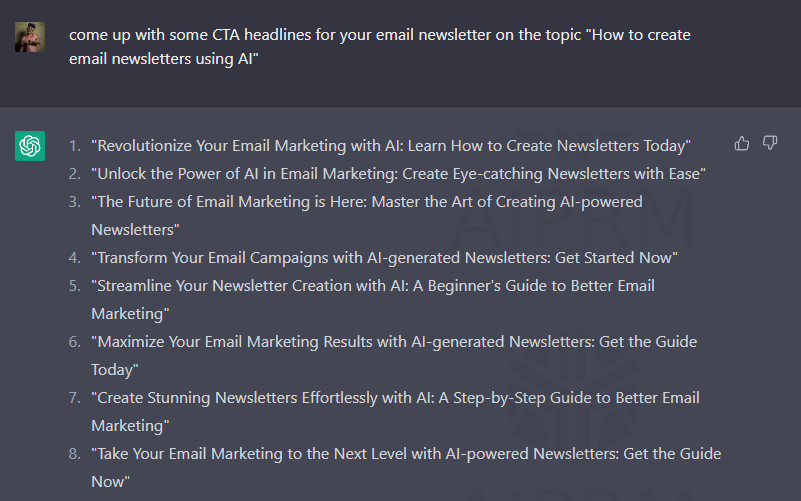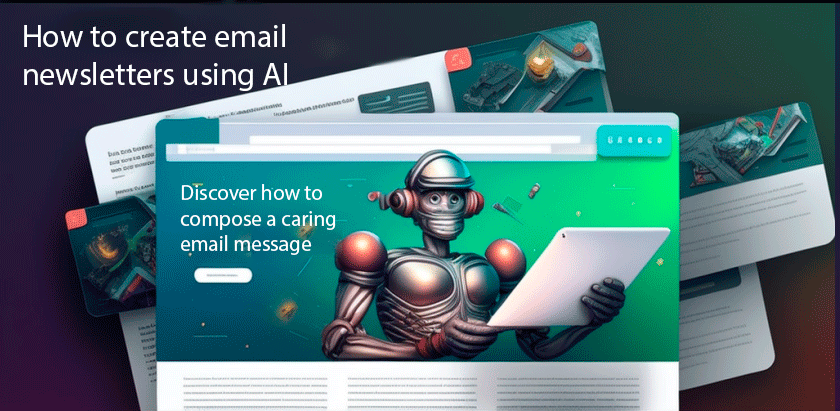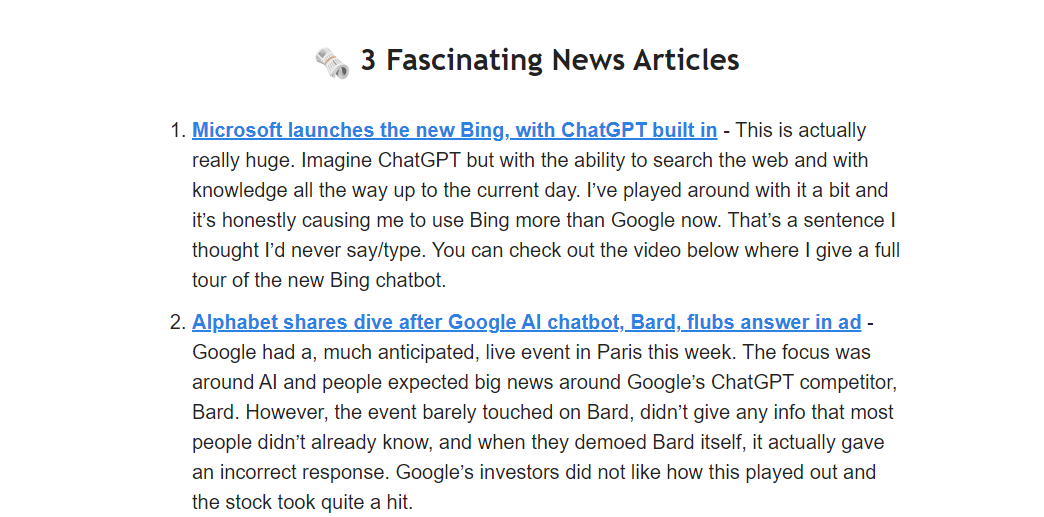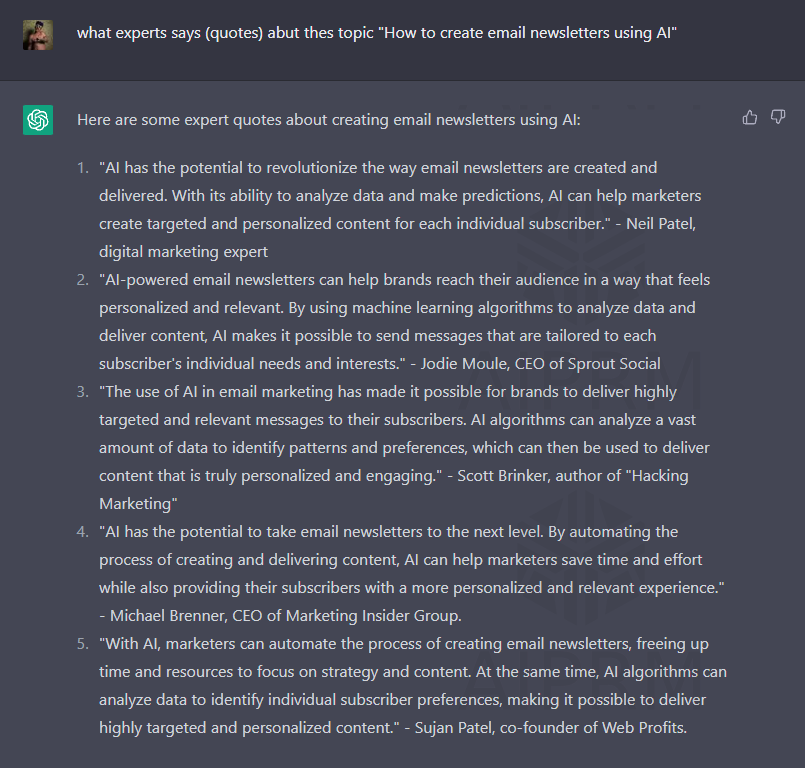The outcome of sending consistent, high-quality emails will be worth the effort; emails have the highest ROI compared to other content types — a remarkable $42 return for every dollar spent. Most marketers rate email as their main way to connect with customers, but only 18% consider themselves advanced email writers.
Email newsletters can be used to maintain connections with followers, share helpful info, and spotlight your company. However, with companies now struggling to be seen in inboxes, it's not easy to create newsletters that stand apart. To make the job easier, you can take advantage of AI to craft stimulating newsletters that captivate readers and make them eager for more.
Crafting great emails requires using proven formulas to make them enticing; these structures can be adjusted by adding personal stories and research. Writing effective emails has two objectives: increasing sales and nurturing leads by raising awareness. With the help of this article, you will no longer dread writing emails, but rather approach them with confidence! Emails are crucial for a company’s success, so don’t pass up learning about this type of content!
Few significant points about composing emails.
Before we start writing, it’s important to understand the most important rules for crafting any email. Clarity should always be prioritized over cleverness; unless you’re a master of wry, sarcastic, or punny writing styles, attempts at cleverness are likely to get in the way of readers understanding your message.
Keep your language simple and make sure that benefits are emphasized over features. Writing in a consistent voice and tone is key; if your brand (or client) doesn’t have any brand guidelines established, look through their various channels to find the most appropriate tone and apply it in emails.
It's also important to speak directly to the reader; use a second-person perspective when possible.
Ensure that emails are always relevant by sticking to the subject declared within the title and honoring email objectives. When these hints have been considered, we can progress to exploring what should be incorporated in all emails regardless of the type.
It is usually necessary to use the second-person point of view when constructing sentences and phrases, using words such as "you" and "your", even if the tone of voice is formal. Have a look at how these two sentences vary: "To craft an effective email, you must concentrate on the reader," (second-person) compared to "For producing a profitable email, one must focus on the recipient," (third-person).
Keeping content relevant is not only about staying on point; it is also about being aware of what your audience wants and does not want to hear. Don't take emails as an opportunity to express your own thoughts and beliefs. You can do so in other outlets like Instagram stories, but even then you should make sure that it relates to your audience's needs and issues. Now that we have covered this information, let us proceed to discussing the main elements for every type of email.
The list of 5-minute email writing tips, to use your 5-minutes wisely
It doesn't matter what type of email you are sending, all of them require four key components to function effectively. This is essentially a headline, a visual element, an attention-grabber and a link/action button. Let's review each separately and investigate how each one plays its part.
Craft Engaging Headlines with AI: Stand Out in the Inbox and Boost Email Open Rates
Your email headline is a significant part of your entire email, as it sets the atmosphere for the message you want to convey and encourages the reader to open your email. If you do not pay attention to your headline, there will be no opens or clicks in your email. It can also be easily lost among a lot of other headlines and advertisements in users' inboxes. You should go the extra mile to make your emails interesting enough for people to open them. As you practice writing more email headlines, your skills in this area will improve. Taking a look at old emails that had effective titles can help you learn what clicked with the audience. A great tip for crafting an engaging headline is to only promise what is inside your email — don’t go overboard in raising expectations too much as this will lead to disappointment when the reader finds out that what was promised isn’t there.
To make your headline stand out from the rest, use imaginative linguistic structure with detail-oriented words and dynamic verbs — ensure it is captivating! For example: lackluster header: «upgrade your phone with a new stylish and durable case.» luster-y header: «what’s poppin» t-shirt wise?' + bonus preview text: «These tees are a-trending.»
The title of your email is the most important aspect of the content. It serves two main functions:
1. Create a tone for the email.
2. Enticing the reader to open it.
If you don’t pay attention to your headline, you won’t get anywhere in terms of readers and clicks. Additionally, it’s important to remember that your headline must stand out among the plethora of other headlines that appear in people’s inboxes, which can include ads as well. Writing effective email headlines takes time and practice. Reviewing old emails and their open rates helps you understand what works well so you can learn from both mistakes and successes alike; this is one great tip for writing better emails!
Ensure that you are accurate in the title of your email; be straightforward regarding what is included so people don't have excessively high hopes. Otherwise, if there is not much content apart from being driven to purchase something, confidence in your organization will be weakened. To make a great headline stand out even more, use creative language with strong verbs and adjectives! AI tools like Chat-Gpt or Jasper can help generate ideas for headlines or even whole emails when starting from scratch; however, they are still learning so be prepared to ask them to rewrite something if necessary!

Make a Powerful Impact with Images: Enhance Your Emails and Quickly Engage Your Audience
It is clear that images can be processed much faster than written text, as our brains are wired to interpret visuals in fractions of a second. Using visuals in content, such as emails, then makes complete sense, as it can quickly engage your audience. Therefore, I suggest including one photo in every email to make your message more powerful and engaging. This image can significantly deepen what you are trying to say, as a single image can often express a hundred words or more.
Grab Your Reader's Attention with a Powerful Hook - Create Emotional Connections with Your Email Content Today
Every great email needs something to capture the reader’s attention. Your hook can be used for many purposes, like stimulating curiosity, creating a connection, or stirring up emotions (or all of these things!). Here are some examples that worked well for me: for instance, I said «it sucked» when I was recounting my experience with trying to find a good writer.
This immediately made readers ponder — «What was it that sucked?» and even further, «tell me more!». This tapped into the emotions of people who have gone through difficult times with finding writers and related to them on this level. Another example was the statement «the lies society (and sometimes our own brains) tell us need to end». Here I expressed my anger at the false stereotypes which hold back my clients from achieving their goals. This hook made people think about how society misleads us and how our brains deceive us — something most would not have considered before this.
As you can see, a good hook often incorporates emotion in some way or another. The goal is to create something that will be easily understood and provoke emotion from your readers (such as intrigue, optimism, indignation, etc.). Your hook is the part of your email that will attract people to read it, so make sure to create something that will hold their attention.
Drive Engagement with a Direct Link or CTA - Take Your Readers to the Next Step
To keep your readers engaged, you must direct their attention to a link or CTA. This can be a link to a blog post, a giveaway, or a sales page, depending on your purpose. Your aim should be to develop a snowball effect; the more you propel the readers forward, the larger their engagement with your work will become. Adding a CTA or link in each email is an effective way to get readers to take your desired action.
You could phrase it as: The link in your email can be direct, such as the message we sent out to our audience to promote a new blog post. We have gathered all the necessary elements for making effective emails, and can combine them in various ways to produce any email your brand needs. Let's start with those that feature a blog.
Discover how to compose a caring email message
This kind of email is the easiest one to compose and its purpose is straightforward -- it lets your mailing list know about any new blogs, podcasts, videos, or other content you have released.

You can recycle a lot of the material from your blog when crafting this type of email. When a recent blog goes live on our website, I send out an email. We've changed to a weekly "best of" format lately because we now have our own podcast and weekly blog post.
This allows us to summarize the whole week's work in one message rather than sending out multiple emails for each post. Our open rate averages around 22% or more depending on when I send it (usually mid-morning or early evening). The title must be interesting enough so that people may look forward to something valuable every week, for instance, "Weekly Best of: How to Increase Content Effectiveness."
Sending out this type of email is important as it keeps your audience informed about your new content and drives traffic towards it, as well as strengthening their connection with you. If you need some ideas on how to do this properly, take a look at Ann Handley's Total Anarchy Newsletter (annhandley.com/newsletter), Mark Schaefer's {grow} newsletter (businessesgrow.com/subscribe), and Eddie Shleyner's.

The headline reads "Seven small observations on marketing right now" to grab our attention. The author shares a story about a toilet, and throughout this newsletter, he continues to do just that: inspiring us with his own ideas, what trends he’s noticed, news that piqued his interest, and more.
This is a great example of how nurturing people means conversing with them and getting intimate with them—not just sharing information without any context or connection. To understand how much difference an expert writer can make, take Paul Klein’s Bizable.tv as an example. Before I coached him and trained his writer, Paul was struggling to keep up with the emails he had to write. Afterward, though, you can see a dramatic improvement in their content! I’m such a fan of the transformation that I look for Paul's emails in my inbox every week!
A straightforward weekly summary is a great way to form strong relationships with your audience. TextScout routinely sends an accumulation of our blog posts and other new material to a continually increasing mailing list.
Marcos from Misaias.com, who had signed up for our Weekly Digest service two weeks earlier, said: "I'm already liking the product, but this Digest is like gold. Knowing it’ll arrive each Friday makes it a bit of a treat! Thank you so much for this helpful content you share (including YouTube videos). You have a devoted subscriber and affiliate-promoting marketer here!" Through this, it should be quite obvious how important sending regular emails to create trust can be. Now let's look at how to write each part of these trust-building emails, whether it is introducing new content or sharing one of your lead magnets.
Headline: Email Subject Line for Blog: "Generate Leads The Right Way: Discover the Forward Flow" Email Subject Line for Video Interview: "Harnessing the Power of Your Brain with Lauren Johnson (Paul Klein)" Email Subject Line from Total Annarchy: "Write Sales Copy That Avoids Being Too Cheesy" (Ann Handley) Email Subject Line from {grow}: "Measuring Performance with Influencers: A Longer Journey" (Mark Schaefer)
Image: Add a picture to the opening of your blog post. Utilize the same illustration you employed for the blog, primarily if it was made for the post. Select an image that signifies the principal idea of your blog article or a principal element.
Hook: To get the most out of your blog, you should consider rewriting the introductory section or the initial 200 words to create an effective hook. Make sure also to be punchy and create a dialog, such as by asking questions or telling a story that is linked to the content you're promoting. As an example, take a look at the TextScout blog intro that was reused in the email to advertise it.
Blog Link: Put a link to the blog you are pushing in the email. Placing it near the bottom after the persuasive introduction is best, as it will draw the reader's attention and likely result in them clicking on it.
How to Write a “Give Value” Email
The next kind of email after the "introductory email" is referred to as the "give value" email. This content is created to give readers an incredible advantage and make them delighted that they registered for your email list. Here at TextScout, a few individuals even responded to thank us after receiving these emails, which significantly helps to earn their trust. Typically, I would suggest using the "give value" email whenever a free download is released. You can also use it to remind your followers of accessible downloads that they have yet to utilize. To write this kind of email, you need to offer a lead magnet to your readers and motivate them to download it.
Headline: For your lead magnet email, you can use the same title as the lead magnet itself. A great example is "The Profitable Content Marketer Skills Cheat Sheet" on TextScout. You could add a few extra words to the headline to make it more interesting, such as "Grab Yours Now: The Profitable Content Marketer Skills Cheat Sheet."
Image: In a lot of cases, you can reuse photos that have been used on your site or in blog entries. In this lead magnet email example, we specifically used snapshots from the lead magnets we were recommending. Doing this keeps the content more captivating and allows readers to get an understanding of what they can download.
Hook: Your lead magnet email needs to have an attention-grabbing hook to get people to take your free stuff. Make sure you emphasize the benefits of downloading and looking over the material. You can achieve this by stating who the lead magnet is intended for, and how it can benefit them. Explain what knowledge it will provide, and how it can improve their lives.
Link/CTA Simple: You can forgo the landing page where readers have to exchange their info for the lead magnet; just send the link directly to the freebie! Keep the link inline text simple, and make it stand out with a call-to-action like "Download now: [Title of freebie]" or "Click to download: [Title of lead magnet]." To get a clearer picture of how this is done, consider the example of how a complementary deeper course can be subtly promoted. Once you've understood all that's necessary for the lead magnet email, you can view a real-life example to see them in action.
Instructions on creating a sales proposal
Crafting powerful sales emails is not an easy task. It requires being able to successfully convince the reader to purchase what you are offering. Instead of bombarding them with sales language, it is imperative to guide them in the right direction and generate a sense of confidence. It is essential to make them understand that your offer is the best remedy for their issue. Luckily, there is a formula which can help you write a flawless email.

Discovering Potential Ideas for Sales Messages
Before we jump into the formula for writing, let’s first discuss how to come up with topics for your sales emails. Ask yourself some pertinent questions: what product/service are you offering? How can you use storytelling and present value?
|
"The use of AI in email marketing has made it possible for brands to deliver highly targeted and relevant messages to their subscribers. AI algorithms can analyze a vast amount of data to identify patterns and preferences, which can then be used to deliver content that is truly personalized and engaging." - Scott Brinker, author of "Hacking Marketing" |
A hot tip: I suggest using the same themes as those used in social media stories.
Examples of such topics include interactions with potential clients (what queries did they have? What issues did your brand help them to overcome?), vulnerable truths (setbacks and how your brand overcame them), dispelling myths related to your industry, relating what your company does to that of the industry e.g., if it is fitness-oriented, then compare success at the gym with success in marketing (e.g., "consistency in marketing is like going to the gym"). If you're having trouble coming up with something, investigate the history and origins of your customer/brand and use that to create content for your readers.
There could be multiple stories within a larger narrative — all you need is to find them. For example, my TextScout narrative includes starting from scratch, creating unattractive flyers initially, failing four times out of ten etc., which can all be used separately as mini-stories in sales emails so as to connect with prospects and demonstrate the power of our services which have been built upon my own career experiences spanning over a decade. In conclusion, if you want to sell effectively through emails, make sure that there is relatability and empathy.
Headline: Your headline for your sales email should be powerful and one to remember. To accomplish this, try highlighting the instructions and faults that were encountered during the journey. That will give your readers confidence and peace of mind when acquiring your items. For instance, you could go with something like, "What I Gained from Developing Labels That Failed"; this will make them speculate about what was actually learned and show that you understand a complete comprehension of their unfavorable views.
A good headline is never dull or standard — words such as boring, flat, dull, same-old, and obvious should be avoided at all costs! An example of a poor headline is "The content transformation system: the only business program you need!" — this line doesn’t spark any interest in buyers; it just tells them how great it is without giving them a reason to buy. Therefore, it breaks several rules of great headline writing: it overpromises; it’s focused on the company not the customer; and it’s generic and unengaging. Finally, spending time crafting your sales email headlines is essential — don’t settle for the first one you think of but let it develop like a delicious stew over time! Tweak words and adjust sentences until you find that perfect combination that sings like Adele!
Image: No, we're still not overlooking pictures in sales messages. I'm convinced that it's even more essential right now to incorporate an image in this spot. Indeed, images communicate a thousand words, and our brains take in visual information quicker than plain text. They add variety, enthusiasm, and involvement to your email correspondence as well. That's why so many of my offers include a custom picture related to the proposition. When it comes to including one, keep it uncomplicated. Position an image at the top of your email with the content underneath. Make sure the image is related and, if possible, branded.
Hook (Story/Value): The headline of any sales email is like a mast, and the hook serves as the rudder. It will guide the message and communicate to prospects why they should take an interest in your solution. At this point, you should use stories and value to illustrate your point. Narrate a tale that clearly expresses how your product or service can bring about great advantages or desirable outcomes.
Make sure it is linked back to the purpose of the brand too. For example, I'll start my sales email with a story about how I expended much effort yet still failed to build two successful brands. Next, I connect the root cause of that failure to a common challenge faced by many entrepreneurs: my notion was great, and I presumed the world needed it… But no one wanted it.
Therefore, we delve into how biz owners can dodge this recurrent problem: with my service! From my story to my target audience’s difficulty to my proposed remedy, it all fits together perfectly. One leads directly to the next then moves on to the subsequent one, like mild droplets of rain amassing in a container. A few drops alone won’t make any difference, but if it continues raining lightly, eventually the basin will get full. And that is precisely what you desire.
Link/CTA (Offer): Now, this is where your actual proposition comes in. This part of the email requires just as much attention as the other sections, since how you phrase the offer will decide whether your prospect decides to opt in or not. It might seem intimidating, but there are a few key points that will make it easier. First: no hard sell. Terms such as "buy now", "limited time offer", "act now" and so on are considered spammy and create a false sense of urgency - something you don't want.
We don’t want to force anyone to acquire our product/service; we’d rather they purchase it of their own volition, once they recognize the advantages it brings. It’s important to remember that with holistic content marketing, we have already been building up their interest, trust, and loyalty with content beyond emails (like blogs, social media, etc.). Rather than a hard sell, it is now more effective to use a softer approach. This type of strong, pushy tactics can be unappealing to many people. When making an offer, try to be encouraging, rather than negative, as this will be far more successful in gaining customers. Examples: "don’t miss this opportunity!" or "you don’t want to miss out on this" or "this could be a great addition to your life!".
Try to make your call-to-action inviting and not compulsory.
Here's an example we have used in a real email: "P.S. Have queries? Interested in discussing the strategy? Schedule a free call with us here!" Don't neglect to feature a connection to the sales page, registration page, or application page for the product you are offering; it's suggested that you attach the action word or phrase in your call-to-action (for example, "apply", "download", "enroll", "sign up", etc
The language should be gentle in promoting; for example, «see if you’re eligible by applying now», «schedule a complimentary call», and «no pressure». We are not pushing or demanding-we are inviting.
Last but not least, remember that concise and clear messages will always trump those that are verbose when it comes to sales emails. Make sure your message is straightforward, succinct and easy to scan through so readers can grasp the concept of your proposal quickly. Be prepared to view the components of a successful sales (presentation) email in action? Follow me.
Rules for Sending Emails (What to Send & How Often)
When sending emails, I stick to certain principles to ensure they remain consistent. My rules include sending value emails on Monday-Wednesday once or twice, as well as sales emails on Thursday-Sunday once.
Send Emails every other week.
It is highly recommended that you adhere to a consistent timetable for sending emails to your list so as not to inundate them. Ensure that you provide plenty of quality material on a regular basis to make certain that your campaigns are successful. Studies have found that the most beneficial days to garner email opens are Tuesdays and Thursdays. The most successful time slots for returning beneficial results are between 10 a.m. and 2 p.m. To verify that this works for your audience, experiment with a variety of times to note the reaction you get.
Send One Value-Focused Email Monday- Wednesday
It should be so that you provide valuable material to your subscribers. For example, TextScout sends two emails every week - one for a blog post and one for a podcast. These emails just feature a link and no unnecessary talk, and the material is of the highest quality. To learn more about crafting value-rich blog content.
Send One Offer Email Thursday-Sunday
Earmark the end of the week for distributing your offer email, Friday mornings and Saturday afternoons are an ideal moment. Frequently, people are in a peaceful and reflective disposition and more likely to read and act on our promotions if we craftily dispatch them Friday a.m. or Saturday midday. One more thing: abstain from replicating and pasting your offers. Create a unique offer for each email you send out. Just as you would not duplicate a blog post upon publication, do not send out repeated emails. Make sure to create new content each time an offer is distributed if you want users to respond positively.
To make the proposal even more attractive, add an additional call-to-action to your sales email. Perhaps you could suggest that they schedule a no-cost consultation with your company or obtain a free guide. If you look at the offer email example, this is exactly what we did. This piques the curiosity of those who are not yet ready to purchase but still have an interest.
Weekly guidelines for email writing: put importance on value & nurturing (always first) sales proposals typically get more traction later in the week and on weekends. Begin the week with value, offering insight into the primary parts of an email:
- headline
- image
- gripping link/CTA
- focus on clarity not creativity
- be brief instead of wordy
- be succinct instead of verbose
Some emails should provide only value (no promotional material). Others should offer deals but present them through a story and give them worth. Refuse to accept aggressive sales tactics ("purchase instantly!"; "be quick!"). Use a mild, appealing, supportive, and affirmative approach when sending emails. Aim to send them twice a week on a consistent schedule. Don't just copy and paste material; produce unique content for all emails.
How AI Can Improve Your Newsletter Content?
One of the biggest benefits of using AI for your email newsletters is that it can help you create more engaging, personalized content. By analyzing subscriber data, AI algorithms can identify patterns and preferences, and use this information to create tailored content that resonates with each individual subscriber.
For example, AI can analyze data on subscriber behavior, such as open rates, click-through rates, and purchase history, to determine what type of content they are most likely to respond to. This information can then be used to create content that is more relevant and valuable to each individual subscriber, which can lead to higher engagement rates and increased conversions.

How AI Can Streamline the Design Process?
In addition to improving the content of your newsletter, AI can also simplify the design process. AI-powered design tools allow you to create visually appealing and well-organized newsletters with ease. These tools use algorithms to generate designs that match your branding and look, without requiring any manual design work.
You can use AI design tools to create personalized templates for your newsletters with attractive visuals and engaging layouts. Using automated design processes allows you to generate multiple versions of your newsletter to ultimately produce the best output.
Conclusion
In conclusion, incorporating artificial intelligence into your email marketing strategy can provide numerous benefits, such as increased efficiency. AI automates various time-consuming tasks associated with creating and delivering newsletters, allowing you to focus on more important aspects of your business.
AI also provides the ability to create more personalized and relevant content for each subscriber, leading to higher engagement rates and increased conversions.
By using AI-driven design tools, you can quickly create stunning and high-quality newsletters, which will increase the effectiveness of your email campaigns and raise engagement levels.
Incorporating AI into email marketing can revolutionize the way you do business. Whether you're just starting out or looking to improve the performance of your mailers, AI technology is an invaluable asset that can help you construct high-quality newsletters that attract and retain readers.





Тут еще никто ничего не писал, стань первым!